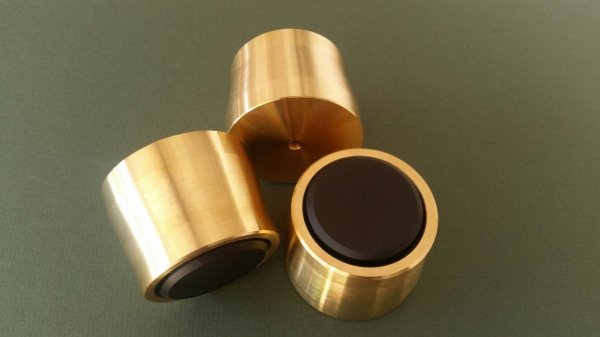Theophile, yes I’m indeed finding this.
It looks like the floor here is a more variable factor than my one back in London.
In London I lived in a converted factory loft apartment block, where the floors were truly solid and unyielding, reinforced concrete and uber solid wood.
Here, there is a lot more flex, being Victorian joists, and this roof structure never housing a domestic room in the 150 yrs Plus of its existence.
I believe it’s this plus the crazy span my room sits on ie 50’ x 35’ which means that the Stacores are proving so much more useful and practical than I could have envisaged.
spirit,
The floor under my isolation is concrete slab, yet I still find that the sound I achieve with regard to my isolation support
interacts with the component atop the support. We are dabbling our toes in a vast ocean which begs to be fully explored.
I have
proved to myself that the process of isolation can be a combination of the benefits of isolation
along with a modification of the sound of the component. You have experienced the benefits of isolation. Now you are experiencing the manner in which your isolation platform is interacting with/modifying the sound of your component. Both can take place simultaneously.
I posted about being able to tune the sound of my isolation support at the AudioKarma site. It goes over the heads of most people because they haven't carried out my experimentation. You are carrying out experiments now. You are honestly reporting your findings. I understand your observations. I cannot explain the mechanisms of why this occurs, but I can confirm that your observations are true and honest.
I actually feel that some isolation methods only rely on the modification of the sound aspect and essentially fail to properly isolate. A pleasing euphonic modification of resonance which meets which consumers approval.
I feel that there are no true 'one size fits all' isolation solutions. Success, I feel, lies in having a method which is able to achieve the goal by optimisation of the isolation method. The basis I feel of optimisation comes from matching the load to the isolation method and getting the component's center of gravity evenly carried by the individual isolation elements(which in my case are comprised of the individual mag-lev pieces and the cups and balls). Too many people are satisfied to purchase and own a particular method but seem to think that there is no further work required on their part other than placing the audio component atop.
I have had posted on other sites and had contributors to my threads on this subject dismiss center of gravity as unimportant, but
I promise you they could not be further from the truth. The designers of rockets will tell you that if they do not take this very important factor into account there will never be success and only be disaster. Designers and engineers of racing cars know how important it is and work very hard to design everything around it. If they fail there will only be disaster. Isolation needs to factor it in also, yet I know of only one audio designer who speaks about this. It is perhaps the case that others know and don't want to reveal the advantage they have over their competitors.


